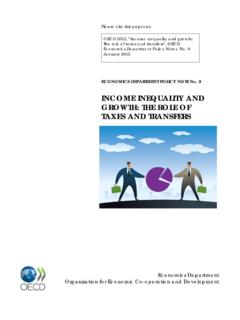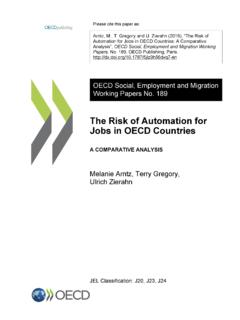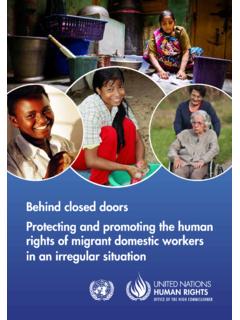Transcription of Conflict, migration and food security
1 FAO-IFPRI JOINT BRIEF Flickr Farran for UNAMID Conflict, migration and food securityThe role of agriculture and rural developmentProtracted conflicts around the world have been a main cause of a rise in global hunger in recent years. conflicts are also driving the dramatic increase in the number of forcibly displaced people from 40 million people in 2011 to almost 66 million in 2016 (Figure 1a/b) (UNHCR, 2017;1 World Bank, 2017). Rural areas are bearing the brunt of these conflicts , and rural populations are most severely affected (FAO et al., 2017). Conflict is often compounded by drought and other climate shocks, exacerbating the impacts on rural food security and livelihoods.
2 migration is one way people try to cope. But forced movements of people and food insecurity may also fuel conflicts . While the impacts of this vicious circle are obvious, the causes can be complex. How conflict creates food insecurity, and when conflict and food insecurity drive people to abandon their livelihoods and migrate, differ from place to place. Where do we begin to prevent and mitigate these complex problems? Responses should start from a clear understanding of the root causes underlying conflicts , movements of people, and persistent food insecurity. While humanitarian aid is essential in the short-term to prevent food crises and famines, FIGURE 1a Rising number of undernourished people in conflict-affected countries, 2011 2016 (millions)Countries not affected by conflict0100200300400500600 Countries affected by conflict20112016 FIGURE 1b Conflict has driven up the number of forcibly displaced people, 2011 2016 (millions)Countries not affected by conflict010200300400500700 Countries affected by conflict20112016 Sources: UCDP for classification of countries affected and not affected by conflict; FAO for data on the number of undernourished; UNHCR for data on forcibly displaced people.
3 The data for forcibly displaced people refer to the country of origin and therefore exclude stateless people and populations for whom the country of origin was not UNHCR estimate of the number of individuals that were forcibly displaced (as a result of persecution, conflict, violence or human rights violation) in 2016 includes million refugees, million internally displaced people, and million solutions will require programs and support measures that address these root causes by providing people with the means to rebuild their livelihoods. Restoring agriculture, food production, and rural livelihoods before, during, and after conflict will be key to building sustainable , migration , and food insecurity Conflict, forced migration , and food insecurity can feed into each other, creating a vicious circle for rural populations (Figure 2).
4 The State of food security and Nutrition in the World 2017 highlights that, because many conflicts are fought in rural areas and target productive agricultural assets such as infrastructure, land, and livestock, the economic impacts often hit agricultural sectors disproportionately hard. Many of the countries affected by conflict and civil strife are largely rural, with some 60 percent of the population living in rural areas (FAO et al., 2017). Those living amid violence often face a difficult choice: risk becoming victims of the conflict or migrate and face a highly uncertain staying and leaving carry high risks. Available evidence suggests that insecurity is a main reason why people abandon their livelihoods and migrate in search of safety.
5 food security , strong social networks, and better livelihood opportunities, in contrast, are key reasons people opt to stay where they are. A recent World food Programme (WFP) study found that the greatest refugee outflows are from countries not only experiencing armed conflict but also the highest level of food insecurity (WFP, 2017). This suggests that working before a crisis arises to establish resilient food systems could reduce food insecurity and the pressure to migrate in times of conflict. A survey conducted by FAO to assess the state of the agricultural sector in the Syrian Arab Republic found that after six years of conflict almost all (94 percent) of those interviewed in local communities said that increased support for agriculture would discourage people from leaving their livelihoods and would encourage many who had already migrated to return to their homes and farms, the safety situation vicious circleConflicts increase food insecurity and limit the livelihood options of rural populations.
6 Conversely, food insecurity driven by sudden food price spikes, dispossession, or loss of agricultural assets may compound existing grievances and trigger conflict. food insecurity and outmigration may disrupt existing social cohesion in local communities. For example, increases in food prices and food insecurity may increase perceived marginalization and exclusion (Breisinger, Ecker and Trinh Tan, 2015). When grievances are formed along ethnic or religious lines (or other forms of social cleavage), discontent may lead to violence (FAO, 2017a). In Yemen, for example, the worsening economic situation and deterioration in people s living standards, in combination with government s inability to effectively address economic and social challenges, were identified by IFPRI research as important factors that sparked the civil unrest that led to civil conflict (Ecker, 2014).
7 Although the causal relationships among these factors are never straightforward (FAO et al., 2017), together the impacts of conflict and food insecurity influence people s decisions to migrate or not. A vicious circle can emerge when conflict leads to a worsening of the food and nutrition security situation, which in turn increases the risk of deepening and prolonging the conflict. Recent empirical evidence shows that food insecurity, when coupled with poverty, increased the likelihood and intensity of armed conflicts . This has clear implications for refugee outflows and internal displacements. The WFP estimates that refugee outflows per 1,000 population increase by percent for each additional year of conflict, and by percent for each percentage increase of the prevalence of undernourishment (WFP, 2017).
8 Currently, an estimated 122 million of 155 million stunted children live in countries affected by conflict (FAO et al., 2017).Conflict may be intensified by movements of people driven by food insecurity and poor access to natural resources. Insecurity, desertification, and loss of grazing land have driven nomadic herders from northern Nigeria to the country s central and southern zones, where they have clashed with sedentary agrarian communities. With an estimated death toll of 2,500 people in 2016, these clashes are potentially as destructive as the Boko Haram insurgency in the northeast of the Many communities in low- and middle-income countries accommodate disproportionately large influxes of displaced people over extended periods of time.
9 This may have a negative impact on local markets, infrastructure, and services. The socioeconomic changes brought about by large inflows of migrants may adversely affect social cohesion in the receiving communities,3 and tensions between the host communities FIGURE 2 The conflict- food insecurity- migration nexusConflictForced MigrationFood InsecuritySources: See, for example, International Crisis Group, See, for instance, Mabiso, Maystadt, Vandercasteelen and Hirvonen, the displaced people may be aggravated by perceived or actual inequality in the access to and use of natural resources, such as agricultural land, water, grazing areas, and fuelwood. Such tensions may culminate in new violence, often including gender-based and sexual violence.
10 Competition for natural resources, in turn, may be detrimental to the food security of vulnerable rural households and can culminate in conflict, especially in contexts of severe natural resource scarcity, deep-seated inequalities, or both. Post-conflict situations and changing drivers of migration In the aftermath of a conflict or crisis, power balances tend to shift, which can create new socioeconomic opportunities. Seizing such opportunities will be critical for sustaining peace and avoiding relapses into conflict. If this succeeds, pressures to migrate are likely to lessen and people may be motivated to return to their may continue in post-conflict contexts, however, if people s expectations for better and more stable livelihoods remain unfulfilled.















